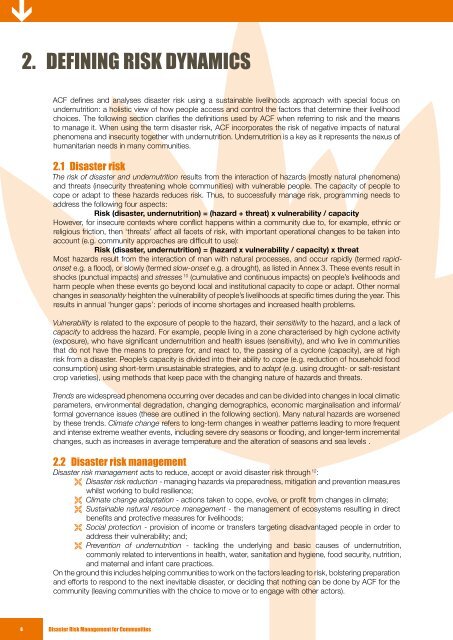DIsAsTER RIsk MANAgEMENT FOR COMMUNITIEs
DIsAsTER RIsk MANAgEMENT FOR COMMUNITIEs
DIsAsTER RIsk MANAgEMENT FOR COMMUNITIEs
- No tags were found...
You also want an ePaper? Increase the reach of your titles
YUMPU automatically turns print PDFs into web optimized ePapers that Google loves.
2. DEFINING RISK DYNAMICS<br />
ACF defines and analyses disaster risk using a sustainable livelihoods approach with special focus on<br />
undernutrition: a holistic view of how people access and control the factors that determine their livelihood<br />
choices. The following section clarifies the definitions used by ACF when referring to risk and the means<br />
to manage it. When using the term disaster risk, ACF incorporates the risk of negative impacts of natural<br />
phenomena and insecurity together with undernutrition. Undernutrition is a key as it represents the nexus of<br />
humanitarian needs in many communities.<br />
2.1 Disaster risk<br />
The risk of disaster and undernutrition results from the interaction of hazards (mostly natural phenomena)<br />
and threats (insecurity threatening whole communities) with vulnerable people. The capacity of people to<br />
cope or adapt to these hazards reduces risk. Thus, to successfully manage risk, programming needs to<br />
address the following four aspects:<br />
Risk (disaster, undernutrition) = (hazard + threat) x vulnerability / capacity<br />
However, for insecure contexts where conflict happens within a community due to, for example, ethnic or<br />
religious friction, then ‘threats’ affect all facets of risk, with important operational changes to be taken into<br />
account (e.g. community approaches are difficult to use):<br />
Risk (disaster, undernutrition) = (hazard x vulnerability / capacity) x threat<br />
Most hazards result from the interaction of man with natural processes, and occur rapidly (termed rapidonset<br />
e.g. a flood), or slowly (termed slow-onset e.g. a drought), as listed in Annex 3. These events result in<br />
shocks (punctual impacts) and stresses 10 (cumulative and continuous impacts) on people’s livelihoods and<br />
harm people when these events go beyond local and institutional capacity to cope or adapt. Other normal<br />
changes in seasonality heighten the vulnerability of people’s livelihoods at specific times during the year. This<br />
results in annual ‘hunger gaps’: periods of income shortages and increased health problems.<br />
Vulnerability is related to the exposure of people to the hazard, their sensitivity to the hazard, and a lack of<br />
capacity to address the hazard. For example, people living in a zone characterised by high cyclone activity<br />
(exposure), who have significant undernutrition and health issues (sensitivity), and who live in communities<br />
that do not have the means to prepare for, and react to, the passing of a cyclone (capacity), are at high<br />
risk from a disaster. People’s capacity is divided into their ability to cope (e.g. reduction of household food<br />
consumption) using short-term unsustainable strategies, and to adapt (e.g. using drought- or salt-resistant<br />
crop varieties), using methods that keep pace with the changing nature of hazards and threats.<br />
Trends are widespread phenomena occurring over decades and can be divided into changes in local climatic<br />
parameters, environmental degradation, changing demographics, economic marginalisation and informal/<br />
formal governance issues (these are outlined in the following section). Many natural hazards are worsened<br />
by these trends. Climate change refers to long-term changes in weather patterns leading to more frequent<br />
and intense extreme weather events, including severe dry seasons or flooding, and longer-term incremental<br />
changes, such as increases in average temperature and the alteration of seasons and sea levels .<br />
2.2 Disaster risk management<br />
Disaster risk management acts to reduce, accept or avoid disaster risk through 12 :<br />
± ± Disaster risk reduction - managing hazards via preparedness, mitigation and prevention measures<br />
whilst working to build resilience;<br />
± ± Climate change adaptation - actions taken to cope, evolve, or profit from changes in climate;<br />
± ± Sustainable natural resource management - the management of ecosystems resulting in direct<br />
benefits and protective measures for livelihoods;<br />
± ± Social protection - provision of income or transfers targeting disadvantaged people in order to<br />
address their vulnerability; and;<br />
± ± Prevention of undernutrition - tackling the underlying and basic causes of undernutrition,<br />
commonly related to interventions in health, water, sanitation and hygiene, food security, nutrition,<br />
and maternal and infant care practices.<br />
On the ground this includes helping communities to work on the factors leading to risk, bolstering preparation<br />
and efforts to respond to the next inevitable disaster, or deciding that nothing can be done by ACF for the<br />
community (leaving communities with the choice to move or to engage with other actors).<br />
6 Disaster Risk Management for Communities

















